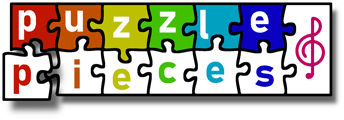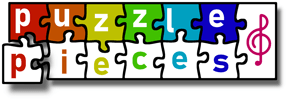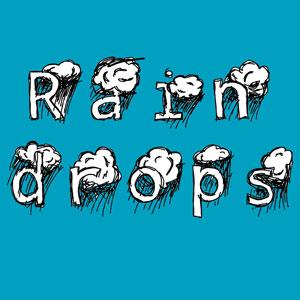-
 Puzzle Pieces: Ode to Joy is of course based on Beethoven's famous finale from his 9th Symphony, used since 1972 as the "anthem of Europe", with powerful brass and percussion in the backing track! N.B. There are only three levels for every instrument in this piece - Bass Line (Level 1), Harmony (Level 2) and Melody (Level 3))
Puzzle Pieces: Ode to Joy is of course based on Beethoven's famous finale from his 9th Symphony, used since 1972 as the "anthem of Europe", with powerful brass and percussion in the backing track! N.B. There are only three levels for every instrument in this piece - Bass Line (Level 1), Harmony (Level 2) and Melody (Level 3)) -
 Puzzle Pieces: Pavane is one of three improvisatory pieces based around chords and using graphic notation rather than staves and notes. This has the same approach as ‘Jazz on Toast’ and 'Daydreamer'- begin with the largest letter in each bar, encouraging pupils to suggest rhythms, or to even improvise a call and response. There are also melody parts for this piece, so there is the option for more variation/flexibility in performance, mixing improvisation with the notated music. It is also possible to build up an accompaniment using the notes from the chord ‘scrolls’, with a soloist playing the melody etc. The difference in style with this piece to the other two ‘graphic score’ pieces could also lead to discussions of different musical styles and eras. Encourage players to perform in a stylistically sympathetic manner!
Puzzle Pieces: Pavane is one of three improvisatory pieces based around chords and using graphic notation rather than staves and notes. This has the same approach as ‘Jazz on Toast’ and 'Daydreamer'- begin with the largest letter in each bar, encouraging pupils to suggest rhythms, or to even improvise a call and response. There are also melody parts for this piece, so there is the option for more variation/flexibility in performance, mixing improvisation with the notated music. It is also possible to build up an accompaniment using the notes from the chord ‘scrolls’, with a soloist playing the melody etc. The difference in style with this piece to the other two ‘graphic score’ pieces could also lead to discussions of different musical styles and eras. Encourage players to perform in a stylistically sympathetic manner! -
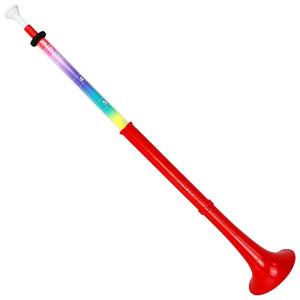 Newly added: pBuzz parts for ALL of the Puzzle Pieces collection. If you have pBuzz groups you can now download PDFs with pBuzz parts to fit with all the other ensemble parts here!
Newly added: pBuzz parts for ALL of the Puzzle Pieces collection. If you have pBuzz groups you can now download PDFs with pBuzz parts to fit with all the other ensemble parts here! -
 Definitely one of the coolest Puzzle Pieces, R&B has a simple drum kit and funky bass backing track. This piece has an 8 bar section for improvisation. Encourage players to try this even if they only use one note for two bars each, or begin by playing their part from the first few bars until they gain confidence.
Definitely one of the coolest Puzzle Pieces, R&B has a simple drum kit and funky bass backing track. This piece has an 8 bar section for improvisation. Encourage players to try this even if they only use one note for two bars each, or begin by playing their part from the first few bars until they gain confidence. -
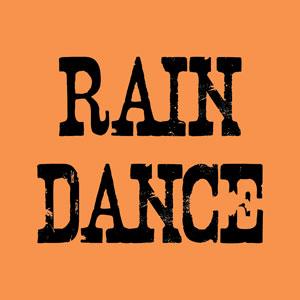 Maybe not one to perform outside?! Puzzle Pieces: Rain Dance takes its lead from Native American traditional rainmaking dances. Wind players might find it better to rest for the first few bars of the repeat, coming back in again at A. Encourage a theatrical approach to the vocalisations and foot stamping at the end! ADDITIONAL SHEETS - Vocalisation rhythm sheet (for tutor)
Maybe not one to perform outside?! Puzzle Pieces: Rain Dance takes its lead from Native American traditional rainmaking dances. Wind players might find it better to rest for the first few bars of the repeat, coming back in again at A. Encourage a theatrical approach to the vocalisations and foot stamping at the end! ADDITIONAL SHEETS - Vocalisation rhythm sheet (for tutor) -
 Puzzle Pieces: Scottish Air gets its inspiration from North of the border, with the skirl of the pipes and rolling drums backing a traditional style Scottish air. In the backing track, listen for the drums after the pause to make the beat more clear at the start! ADDITIONAL SHEETS: 3/4 explanation sheet, dotted rhythms sheet
Puzzle Pieces: Scottish Air gets its inspiration from North of the border, with the skirl of the pipes and rolling drums backing a traditional style Scottish air. In the backing track, listen for the drums after the pause to make the beat more clear at the start! ADDITIONAL SHEETS: 3/4 explanation sheet, dotted rhythms sheet -
 Puzzle Pieces: Shout Out! is a call-and-response piece designed to encourage creativity, leading and improvisation. Lead the ‘calls’ at first, but encourage players to be the leader when they feel confident to do so. Also try changing the sounds on each repeat (e.g. 1st time - all vocalised, 2nd time - clap/stamp rhythm, 3rd time - play the notes)
Puzzle Pieces: Shout Out! is a call-and-response piece designed to encourage creativity, leading and improvisation. Lead the ‘calls’ at first, but encourage players to be the leader when they feel confident to do so. Also try changing the sounds on each repeat (e.g. 1st time - all vocalised, 2nd time - clap/stamp rhythm, 3rd time - play the notes) -
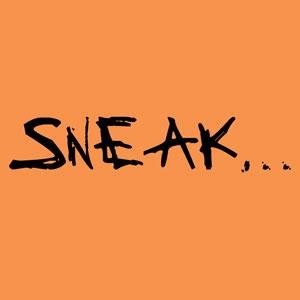 Time to channel your inner secret agent! Puzzle Pieces: Sneak... is all about being quiet and stylish. Try a different approach to each repeat; 1st time - sing quietly, 2nd time - solo instrument (rest of group click on 2+4), 3rd time - all play, CODA bars, maybe add in a pose for the final two notes! ADDITIONAL SHEETS - Song/text to help recognise the differences in rhythm
Time to channel your inner secret agent! Puzzle Pieces: Sneak... is all about being quiet and stylish. Try a different approach to each repeat; 1st time - sing quietly, 2nd time - solo instrument (rest of group click on 2+4), 3rd time - all play, CODA bars, maybe add in a pose for the final two notes! ADDITIONAL SHEETS - Song/text to help recognise the differences in rhythm
